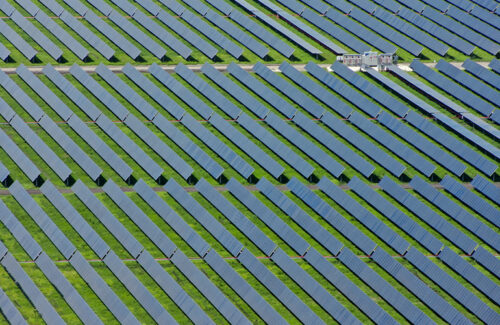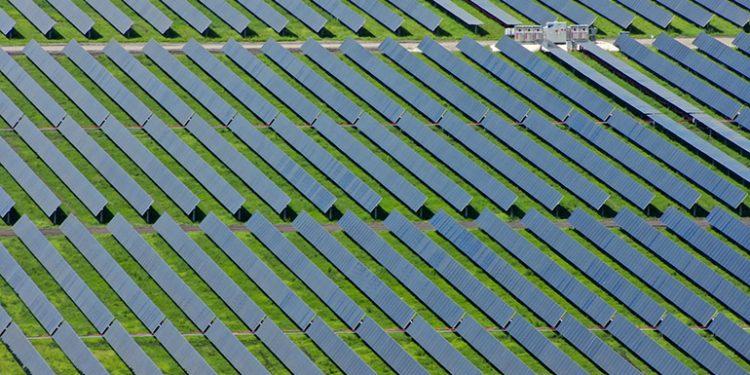
Credit: Lightsource bp
After a vote-a-rama session that broke the record for most votes on amendments and procedural motions, Trump’s budget bill passed out of the Senate and is back in the House. Some of the most extreme anti-solar measures, like a 50% excise tax, were removed. Still, big solar tax credit changes are on the horizon no matter what version makes it to the Oval Office.
Solar Power World got on the phone with Matt Kaden, managing director at law firm Baker Tilly, where he specializes in energy and infrastructure tax policy, to talk through the latest, and potentially final, iteration of the bill. Kaden has been involved in the solar industry for nearly a decade, previously serving as director of tax planning for NextEra Energy. While the end to the residential solar ITC (25D) is a clean break, Kaden says the phasedown of non-residential solar tax credits (48E/45Y) is more nuanced.
This interview has been edited for clarity.
SPW: Could you start by telling me your biggest takeaways for the solar industry from the Senate version of the bill?
Kaden: This stuff is not new to industry veterans. This is actually more like the norm — having a hard cliff or a phase-out was the norm. The investment tax credit, going all the way back to its inception in the ’70s, has always been on a limited timeline, and always gets extended.
Since the 30% ITC was enacted, at least for utility-scale systems, the growth in the solar industry has been pretty constant. It just ramps up, even though throughout that whole period before the IRA, there was the knowledge that it wasn’t going to last forever.
The particulars here are, if you’re able to start construction in 2025, you don’t have any restrictions on the types of components that are in the system, whether they come from China or elsewhere. It’s not 100% clear, but we suspect that the typical begin-construction rules will apply, which means that if you start construction anytime in 2025, you’d be able to place your project in service by the end of 2029 and you’ll get 100% of the tax credits, with all the adders — energy community, domestic content, etc.
Once you start construction, there’s a “continuity safe harbor,” where you have four years to complete it, and then you’ll be tied to that earlier begin-construction date.
But with respect to projects that are forecasting to be placed in service in 2030, you have this decision point where, if I start in 2026, I’ll be in the continuity safe harbor, but I do have to comply with the material assistance rules, which means that at least 40% of my manufactured components have to be U.S.-manufactured.
The trade-off there is if I start in 2025, I can do what’s called “continuous efforts,” which means I have to do a little bit of construction each year, and it’s not a bright-line rule where the four-year safe harbor is. And so, you could say, “Well, I did a little bit for five years, so I qualify under that 2025 started-construction date,” and that allows me to avoid the so-called “material assistance” rules, the prohibition against too many Chinese components.
“Continuous efforts” aren’t as clear-cut as a four-year safe harbor. But it does potentially allow you to start a project in 2025 or 2026 and not place in service until 2031 or 2032. So, there is a good runway here that they put in at the last second.
For residential [third-party ownership companies], they have to follow the four-year safe harbor because you can’t really do “continuous construction” on a rooftop. The way that a lot of residential companies have “started construction” is they warehouse a certain number of panels. There’s a safe harbor where, if you basically acquire 5% of the cost, that gives you a start-construction date. So that’s the play for residential — spend some money now, you have all the stuff warehoused for the next four years.
The restrictions we’ve been talking about, as far as the cut-off to start construction, don’t apply to storage under the Senate bill, so there’s kind of an unlimited runway with respect to storage, at least through 2032. So, if you think about it on a project basis, if you can get 50% ITC on a battery and even 0% on the solar as a whole, you’ve got a 25% tax credit on your project, which is significant.
We shouldn’t lose sight of the fact that storage is so important to the solar industry. That relationship is critical. Particularly for utility-scale developers, and for residential developers too, you have a longer runway with storage, which gives your overall project a boost.
As far as the Foreign Entity of Concern rules, foreign entities could never collect the ITC — they always work through American LLCs. This doesn’t do anything to that setup, right?
Correct. What this is saying is, if you’re a U.S. company that’s eligible to claim the tax credits, but someone has significant influence over your company that is from a prohibited place like Iran or China, or they control your supply chain in some way, even though you’re a U.S. entity, you wouldn’t be able to claim the credit.
That’s going to impact some taxpayers, but not that many U.S. companies are so ingrained with China. Some are, but not so many. What’s more relevant are the “material assistance rules,” which kick in for projects that start construction after 2025. Those rules basically say, if you don’t have a certain percentage of U.S. manufactured product, your ITC goes to zero. If you don’t start construction in 2025, you’re subject to those rules starting January 1, 2026, where you have to worry about your supply chain. You’ll have to prove it out to people who are buying the tax credits, that yes, I meet the 40% test, in 2026. It goes up every year.
But that’s the general idea — you want to start construction as soon as possible, unless you already have U.S.-manufactured products at that level, or you have an easy runway to get there.
How easy is it for utility-scale developers to start construction that quickly? Is that going to be a huge hurdle?
We’re looking at that. Typically, the way it was done was the deep-pocketed developers, the NextEras of the world, they would spend 5% of the project cost, and they would just warehouse all the stuff, and then you don’t have to worry about anything.
The other ways to do it are more “facts and circumstances.” It’s called the “physical work test.” Typically, you’d have a custom piece of equipment, like a transformer, and you contract with a third party to build it, and you’d say, “I have proof that this is not in their inventory, that they did this work made-to-order, and that this is a significant piece of equipment for the project.”
Based on that, as long as that third-party manufacturer did some work — they finished a part of the transformer, they didn’t have to complete the whole thing — that would be enough.
We saw many projects get financed in that way, and that’s not a huge upfront expenditure, but now it’s hard to get a transformer and hard to get work done on a transformer, hard to negotiate that contract.
People that have site control, they could do things like build roads, lay foundations, other things like that that are not just preliminary activities like putting up a fence or leveling the ground. We see that more and more.
The paths forward from here are the House can choose to either bring it to conference or just bring it to a vote. That’s what we’re looking at?
They passed a procedural vote where they’re going to bring it to debate in the House, and they’re going to have a vote in the House I think either today or tomorrow. If they can’t get there, then they can initiate the conference procedures. But then you’ll have to get another vote in the Senate. You’ll have to get another vote in the House. So, a July 4 deadline is certainly out of question if that’s going to happen.
I think there’s a strong incentive, obviously, to make the “Big Man” happy. I’m hopeful that we don’t backslide. I think where we ended up is not perfect. It’s not ideal for the industry, but it’s a place that gives plenty of runway, and if, for some reason, the credits are not extended, as they often are, there’d be enough room to transition into a credit-less environment. But as Milton Friedman, the Nobel Prize-winning economist said — there’s nothing so permanent as a temporary government program.
Energy security is super important. People are not focused on it right now, but with time, and when people are not so focused on just getting this thing passed, I think they’ll understand that. They’ll understand they need all-of-the-above energy. And solar is a great, great way to build baseload, particularly with batteries. I just think we’re in it for the long haul.















